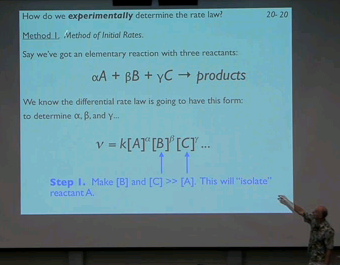UCI Chem 131C Thermodynamics and Chemical Dynamics (Spring 2012)
Lec 20. Thermodynamics and Chemical Dynamics -- The Integrated Rate Law --
View the complete course: ../courses/chem_131c_thermodynamics_and_chemical_dynamics.html
Instructor: Reginald Penner, Ph.D.
License: Creative Commons BY-NC-SA
Terms of Use: ../info.
More courses at http://ocw.uci.edu
Description: In Chemistry 131C, students will study how to calculate macroscopic chemical properties of systems. This course will build on the microscopic understanding (Chemical Physics) to reinforce and expand your understanding of the basic thermo-chemistry concepts from General Chemistry (Physical Chemistry.) We then go on to study how chemical reaction rates are measured and calculated from molecular properties. Topics covered include: Energy, entropy, and the thermodynamic potentials; Chemical equilibrium; and Chemical kinetics. This video is part of a 27-lecture undergraduate-level course titled "Thermodynamics and Chemical Dynamics" taught at UC Irvine by Professor Reginald M. Penner.
Thermodynamics and Chemical Dynamics (Chem 131C) is part of OpenChem: ../openchem/
Recorded on May 18, 2012.
Index of Topics:
00:09 - Introduction: Integrated Law
00:18 - today...
00:41 - Two types of reactions: take for example the following:
02:19 - stoichiometric
03:12 - for elementary reactions...
04:09 - this is another bimolecular reaction
07:14 - How do we experimentally determine the rate law?
17:48 - Method 3 - Use the integrated rate law to define the half-life of the reaction.
20:30 - vs time for a 2nd order reaction...
21:10 - Method 2: Use an integrated rate law.
21:56 - we've mentioned 1st order and 2nd order reactions...zero order reaction.
23:15 - [A] vs time for a 0 order reaction
23:56 - what kind of reaction does this?
24:36 - the microscopic view of "heterogeneous" catalysis
26:00 - some common integrated rate laws.
27:06 - so in reality, we have three methods for classifying a reaction...
28:30 - Method 3. Measuring the influence of initial reactant concentration...
29:08 - example: what % will decompose after one hour?
30:34 - For reversible reactions, we mentioned...
31:34 - Let's start with the simplest reversible reaction:
Required attribution: Penner, Reginald Thermodynamics and Chemical Dynamics 131C (UCI OpenCourseWare: University of California, Irvine), ../courses/chem_131c_thermodynamics_and_chemical_dynamics.html. [Access date]. License: Creative Commons Attribution-ShareAlike 3.0 United States License.


